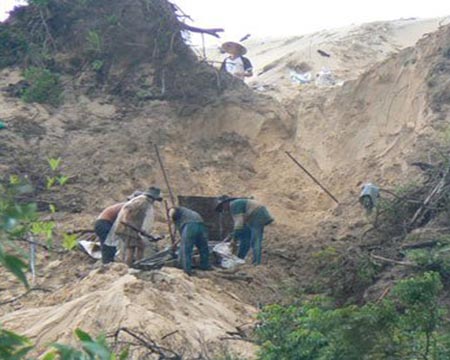Titanium-rich areas facing the perils of the mineral resource
People now have to pay a heavy price for titanium ores. Schools, roads and jobs have been exchanged for seriously polluting the environment.

The post-titanium exploitation perils
The residents in Binh Thuan province say they are now facing the post-titanium exploitation problems. Titanium ores have brought schools, roads and generated jobs to local people. And they have also brought disastrous consequences.
On titanium exploitation sites, local people have been living together with the sand winds which have upset their daily lives. However, more worryingly, they have to live in a fear of the radioactive pollution. The titanium ore exploiters only tried to find as much ores as possible, while they deliberately ignored the measures to protect the environment.According to the Binh Thuan provincial Department of Science and Technology, the radioactivity in titanium exploited areas has been higher than the allowed level. On the key coastal roads from Mui Ne to Bac Binh and from Phan Thiet to La Gi, when it rains, the sand from hill slopes follows the rain water to flow into people’s houses.
The sea water samples taken from the coastal areas in the communes of Hong Phong, Hoa Thang and Bac Binh district all showed the alpha and beta radioactivity higher by 3-9 times than the allowed level.
The gamma radiation background at titanium containing mineral reserves is 26 - 36 times higher than the natural background radiation. The underground water has also been found as seriously polluted at 10 meters in depth.
The Binh Dinh provincial science and technology department has also measured the radioactivity in the titanium exploited areas and found out that the radioactive contaminated area has the width of 200-500 meters and the length of six kilometers.
Dr Vo Ngoc Anh, Deputy Director of the Binh Dinh provincial Department of Science and Technology, has pointed out that the process of exploiting, processing and using minerals has increased the capability of the radioactive elements penetrating into the environment, thus causing radioactive pollution.
Anh has made public his research work on assessing the radioactivity in the titanium exploited areas in the coastline of Binh Dinh province.
Anh has also found out that the people living in the titanium areas and the workers at titanium sifting workshops face higher risks of getting radiation contamination than in other areas.
According to Dr Nguyen Van Nam from the Geology and Rare Earth Federation, the basic compounds in titanium minerals contain the radioactive substances, including Monazit, very harmful to people’s health.
In the past, the experts from the national atomic energy institute once warned that it is necessary to tightly control Monazit, the substance arising during the exploitation and processing of titanium, as a radioactive substance.
They said that the half-decay time of Monazit may last hundreds of years, and that radioactive waste must be gathered and put in the areas far from residential quarters, water resources, and that the waste must be contained in concrete trenches.
Higher pollution for deeper processing
According to Dr Phung Viet Ngu from the Metallurgy Science Association, if heavier investment would allow to make TiO2. However, the deeper processing would lead to the higher level of pollution.
Ngu has warned that every ton of TiO2 would generate 10 tons of waste acid of 10-15 percent sulfuric acid and one ton of iron acid. Therefore, if investors do not choose standard technologies and apply reasonable measures during the processing, they would cause disasters to the environment.

Leave your comment on this story